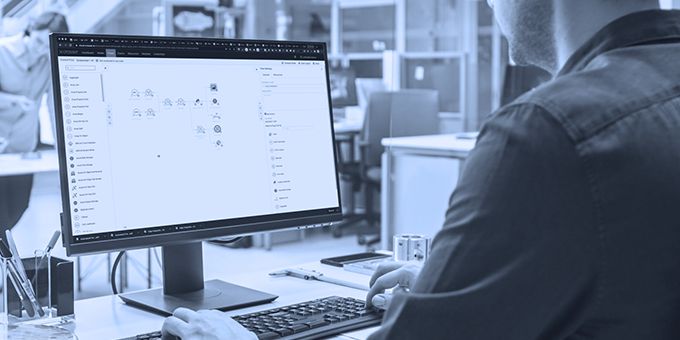Swedish philosopher Nick Bostrom once said, “machine intelligence is the last invention that humanity will ever need to make”. AI decision making, with real time communication and data analytics, has the ability to transform the way manufacturers understand machines.
 AIoT and Edge Analytics: a Powerful Combination
AIoT and Edge Analytics: a Powerful Combination

Johan Jonzon, CMO and Co-Founder | Crosser
Here Johan Jonzon, CMO and Co-Founder of pioneer in edge analytics for the Industrial Internet of Things (IIoT) Crosser, explains how combining AI with the IoT can unlock the next generation of manufacturing.
The IoT and AI are separate technology trends that are both making waves in industry. But, when combined, their benefits are magnified. The IoT can connect devices together, giving and receiving signals like a nervous system. In contrast, AI can act as a brain, receiving data, processing it and using it to make informed decisions that control the overall system.
When joined together, the two are capable of delivering intelligent, connecting systems that can self-correct and self-heal themselves — forming the Artificial Intelligence of Things (AIoT). According to Research and Markets, the global AIoT market is expected to reach over 65 billion US dollars by 2025, growing at a compound annual growth rate (CAGR) of nearly 40 per cent.
Take action
To appreciate the capabilities of AIoT, it’s helpful to reflect on the impact IoT has already made on industry. With IoT technologies such as cloud computing and storage, as well as enhanced connectivity and machine-to-machine (M2M) communication, manufacturers have been able to complete three key tasks: connect machines, store data and make it meaningful. Now, as we introduce AIoT, they can benefit from a fourth capability — to act.
Now, manufacturers can be presented with more than just facts. Instead of only learning about how their equipment is performing, and needing to the make their own decisions on how to act upon these findings, AI is closing the loop by automatically taking action.
However, to make AIoT feasible, manufacturers need a data management system that can support fast decision making. While cloud storage is a viable option, analyzing data closer to its source — at the edge — will take AIoT to the next level.
Enter the edge
In many cases of AI integration, activities need to occur locally to act fast. For example, if the AI system receives an alert that there is a machine fault, the AI system may make the decision to stop the machine to avoid product damage. By integrating the AI system at the edge, instead of the cloud, latency issues can be avoided, meaning the machine is switched off much quicker and fewer products are damaged.
The same is applicable for process optimization activities, such as changing the speed or type of movement of a machine. An AI system at the edge can send instructions to equipment to improve its performance faster than from the cloud.
An additional benefit of integrating AI and processing data at the edge is increased security. Cloud computing can present a number of security issues, as the data is stored by a third-party provider away from the company’s premises, and is accessible over the Internet. Edge computing can work as a complement to overcome these security concerns by filtering out sensitive information at the source and storing it on-premise, so there is less transfer of confidential material to the cloud.
Another use case where it is advantageous to integrate AIoT at the edge is when visual inspection systems are involved. Cameras and sensors create massive amounts of data, and therefore it makes better sense to analyze and filter this data at the edge, instead of sending it all to the cloud or large centralized system.
In addition, facilities often have a high number of mobile devices connected to the AIoT, and are therefore handling a huge amount of data. Sending all of this data to the cloud may not be possible, so it’s better to conduct the analysis at the edge. Edge analytics can extract the higher-value features from the raw data, sending only the important and necessary information to the cloud, such as remaining machine lifetime, for example.
Integrating the AIoT
In order to integrate AIoT at the edge, industry leaders must first build an AI model offline. They must then train the model by using previously stored datasets to improve it and ensure it meets expectations and requirements. Once happy with the model, industry leaders can execute it by exporting and applying it online with new live data.
However, applying the model to real time data in an online scenario is very different to testing it on stored data that has already been sorted in the training stage. Real time data hasn’t been filtered or categorized, and each set can be arriving at different times, creating a chaos of information for the AIoT.
Therefore, something needs to be done to the data before it can be used by the AIoT ― that’s also where edge analytics comes in. The Crosser Platform can help prepare the data in a number of ways before it reaches the AIoT. For example, it can harmonize data that is in different formats as it has travelled in from multiple sources.
 Data that is coming in at different times can be aligned by the platform on regular time boundaries. In addition, if the data sources have different sampling rates, then the platform can fill in intermediate values so that the models can be updated with new data from all the sensors in each update. It can also create different types of windows over time series data.
Data that is coming in at different times can be aligned by the platform on regular time boundaries. In addition, if the data sources have different sampling rates, then the platform can fill in intermediate values so that the models can be updated with new data from all the sensors in each update. It can also create different types of windows over time series data.
The platform can also be used for feature extraction. Depending on the model being used, additional features may need to be created out of the raw data. This could be, for example, taking vibration data and converting it from the time domain into the frequency domain. All of these steps streamline the data before it reaches the AIoT.
It’s true that machine intelligence holds great power, but other supporting technologies can help uncover its full potential. Industry leaders who integrate the AIoT at the edge can reap the benefits of an efficient and reactive control system ― optimizing processes, fast.
To learn more about Crosser and its edge solutions, visit https://crosser.io/
About Crosser Technologies
Crosser is a Swedish software company with installations in over 20 different countries. We design and develop a Low-Code software platform for Streaming Analytics, Automation and Integration for any Edge, On-premise or Cloud. Our aim is to remove complexity, simplify development and to enable non-programmers to innovate faster with a dramatically lower total cost of ownership. Our vision is that there are enormous business opportunities for companies When Machines Talk(™).
The content & opinions in this article are the author’s and do not necessarily represent the views of ManufacturingTomorrow
Comments (0)
This post does not have any comments. Be the first to leave a comment below.
Featured Product

